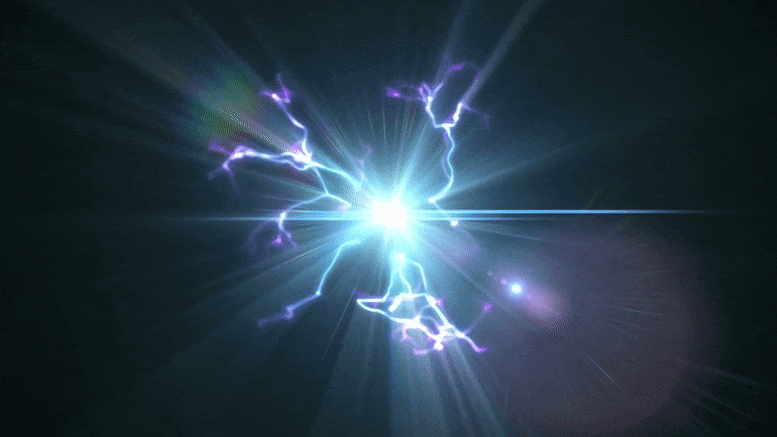
Technology could make it possible to use radio emissions from cell phone networks to wirelessly power sensors and LEDs.
Researchers have developed a new metasurface-based antenna that represents an important step toward making it practical to harvest energy from radio waves, such as the ones used in cell phone networks or Bluetooth connections. This technology could potentially provide wireless power to sensors, LEDs and other simple devices with low energy requirements.
“By eliminating wired connections and batteries, these antennas could help reduce costs, improve reliability and make some electrical systems more efficient,” said research team leader Jiangfeng Zhou from the University of South Florida. “This would be useful for powering smart home sensors such as those used for temperature, lighting and motion or sensors used to monitor the structure of buildings or bridges, where replacing a battery might be difficult or impossible.”
In the journal Optical Materials Express, the researchers report that lab tests of their new antenna showed that it can harvest 100 microwatts of power, enough to power simple devices, from low power radio waves. This was possible because the metamaterial used to make the antenna exhibits perfect absorption of radio waves and was designed to work with low intensities.
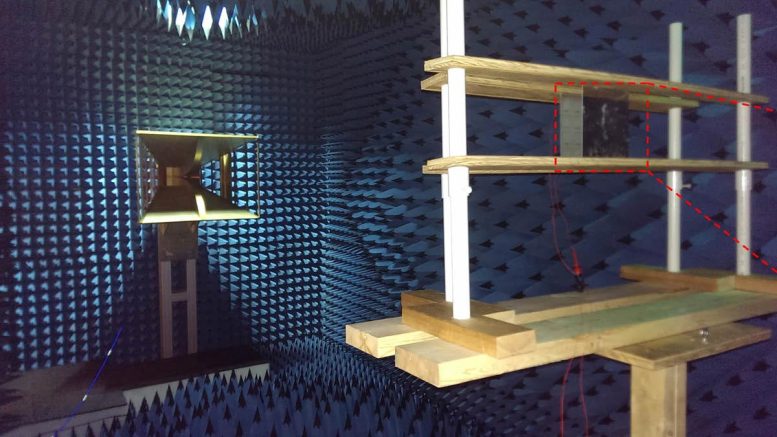
The researchers tested their metamaterial-based antenna in an anechoic chamber. The radio wave is sent out from the horn antenna on the left and received by the metasurface antenna mounted on the wood frame on the right. The anechoic chamber eliminates background signals from other sources and prevents stray signals from the radio wave source from bouncing around the room and perturbing measurements. The image of metamaterial-based antenna is enlarged on the right. Credit: Jiangfeng Zhou and Clayton Fowler
“Although more work is needed to miniaturize the antenna, our device crosses a key threshold of 100 microwatts of harvested power with high efficiency using ambient power levels found in the real world,” said Clayton Fowler, the team member who fabricated the sample and performed the measurements. “The technology could also be adapted so that a radio wave source could be provided to power or charge devices around a room.”
Harvesting energy from the air
Scientists have been trying to capture energy from radio waves for quite some time, but it has been difficult to obtain enough energy to be useful. This is changing thanks to the development of metamaterials and the ever-growing number of ambient sources of radio frequency energy available, such as cell phone networks, Wi-Fi, GPS, and Bluetooth signals.
“With the huge explosion in radio wave-based technologies, there will be a lot of waste electromagnetic emissions that could be collected,” said Zhou. “This, combined with advancements in metamaterials, has created a ripe environment for new devices and applications that could benefit from collecting this waste energy and putting it to use.”
Metamaterials use small, carefully designed structures to interact with light and radio waves in ways that naturally occurring materials do not. To make the energy-harvesting antenna, the researchers used a metamaterial designed for high absorption of radio waves and that allows a higher voltage to flow across the device’s diode. This improved its efficiency at turning radio waves into power, particularly at low intensity.
Testing with ambient power levels
For lab tests of the device, which measured 16 cm by 16 cm, the researchers measured the amount of power harvested while changing the power and frequency of a radio source between 0.7 and 2.0 GHz. They demonstrated the ability to harvest 100 microwatts of power from radio waves with an intensity of just 0.4 microwatts per centimeter squared, approximately the level of intensity of the radio waves 100 meters from a cell phone tower.
“We also placed a cell phone very close to the antenna during a phone call, and it captured enough energy to power an LED during the call,” said Zhou. “Although it would be more practical to harvest energy from cell phone towers, this demonstrated the power capturing abilities of the antenna.”
Because the current version of the antenna is much larger than most of the devices it would potentially power, the researchers are working to make it smaller. They would also like to make a version that could collect energy from multiple types of radio waves simultaneously so that more energy could be gathered.
Reference: “High efficiency ambient RF energy harvesting by a metamaterial perfect absorber” by Clayton Fowler, Sinhara Silva, Grija Thapa and Jiangfeng Zhou, 28 February 2022, Optical Materials Express.
DOI: 10.1364/OME.449494

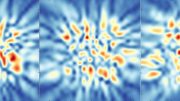
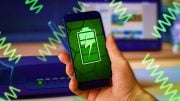

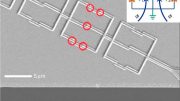
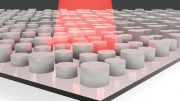


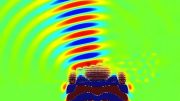
Nichola Tesla did it first
As long as cosmic RF energy is being targeted. Otherwise it’s no different than steeling power from various utility providers.
Wonderful discovery and breakthrough!
Wonderful Discovery?
This is what Tesla was trying to do 100 years ago, until he ran out of money.
The gov should release all of Tesla’s designs the FBI snatched up out of his hotel room the day he died, probably destroyed it anyway.
Thank you to all the other commenters who mentioned Tesla! He was the first thing I thought of when I read the headline, and I was honestly shocked to get to the end of the article and find that the author didn’t once mention him or his research/experiments that laid the groundwork for this very concept!! Author, please do some background research on Tesla (the man, not the company)!
Agreed, Tesla did it first, his research should be looked into, and the government should release ALL documents pertaining to him and his research.
Very dangerous
coils when resonance is achieved
live circuit
Work in faraday cage
I wrote a research paper 15-20 years ago on this subject. Capturing energy from out Ionosphere using radio waves. Sent it out to science mags w/o a response. It’s an easy process whereby free energy would be available world over. The elites for sure fight it, as the all the people are to buy from them what should be free.
Sounds awesome, Gary! Can you share your paper? I would love to take a look at it 🙂
Have fun, boys, it is way better than doing drugs.
Despite the years we have neglected Tesla’s research in this field due to improper filings with the patents office and theft of principle research by Edison, there is still a huge difference in factor in this study and Tesla. In this research, the entire experiment is done in a controlled environment. While this is adequate for an initial test; I’d like to see results from a true testing in attended usage. When you add in all the factors in the conditions the antenna is actually intended, every variant in these studies are altered.